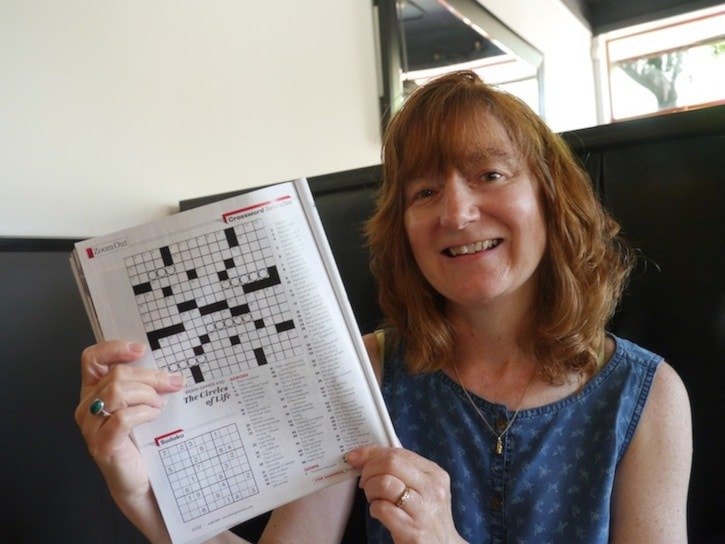Crossword puzzle makers, like many members of other creative groups, get together in online chat groups and debate the legitimacy of words and clues. They’re obsessed. They discuss standards, appropriateness, and meanings.
“I love them,” says Nelson crossword creator Barb Olson. “We get into the nuts and bolts of language, tear apart words, and analyze clues. People will pose questions on the legitimacy of using this or that word in a puzzle, whether it ‘passes the breakfast test.’”
But not all crossword writers are created equal. There are people who churn out computer generated puzzles, employing tired, predictable words and clues, and then there are others like Olson.
“You can tell if a crossword has been done that way,” she says, “because there is a lot of crap in there, there is a lot of crossword-ese — that is language you only find in crosswords, things like ‘anoa.’ You see it all the time if you do puzzles. Or ‘etui,’ which is a needle holder.”
Olson, who has a degree in French translation, started writing crosswords twelve years ago. She has co-authored several books of crossword puzzles with the late Dave McLeod, and has had puzzles in The New York Times, The Los Angeles Times, GAMES Magazine, Saturday Night Magazine, Quill & Quire and Canadian Reader’s Digest. Currently she runs a crossword subscription service,ClassiCanadian Crosswords, where crossword buffs can sign up for a weekly emailed puzzle.
She says there are no more than a dozen people making crosswords in Canada, and many of those, like Olson, only make a partial living at it. She spends the rest of her working life working in a Nelson medical office.
One of Olson's puzzles is attached below. We will publish the solution online on June 15.
An interesting theme is essential
One of the signs of a good crossword puzzle, she says, is that it has a unique theme. One of her recent puzzles has the theme ‘card games.” Many of the longer words and phrases in the puzzle include the names of card games, some of them quite subtly. And she has another in which many of the words and phrases are words for getting fired.
A puzzle without a theme is uninteresting to Olson and she puts a lot of effort into creating original ones.
Her puzzle called Outside Layers has a partly visual theme. All the themed words are around the outside edge of the puzzle, and they are all the names of animals or birds that lay eggs.
New York Times is the standard
Olson says the standard for high quality is the New York Times, which publishes a page of strict specifications for its puzzles.
When Olson does a New York Times puzzle, what is she thinking?
“I am thinking, ‘That is so brilliant and I get such a charge out of it.’ Or I might say, ‘That is kind of cheap, kind of a lame way to clue that word. That has been clued that way so many times, couldn’t they have done it more imaginatively?’
Olson’s tagline on her website is: Always themed, always clever, always Canadian.
Always Canadian content
Canadian content is central to Olson’s crossword work. Although she uses the puzzles in the New York Times and the Los Angeles Times as her model for quality, she does it with a Canadian flavour, “so that you don’t have to know the name of some Republican senator in 1972.”
That involves using Canadian spellings, Canadian historical and geographic references, and hockey.
“I try and throw in as many references to the CBC as I can. If there is an opportunity to use a Canadian reference I’ll do it, but not at the expense of the quality of the puzzle.”
Starting a new puzzle
Olson starts a new puzzle by first coming up with a theme. Then she uses a computer program that presents her with a grid of blank squares. She types in the answers for the themed questions.
“Then I look at those and I might say, ‘hmm, there is a ‘j’ there. Well I don’t want a word that that ends in ‘j’ because it does not happen in English, so I have to be strategic. I want the block to go on top of that letter so that the word will start with a j and not end with one.’”
After filling in the themed words, it’s fair game, sticking to the standards of the best puzzles, and to Canadian content as much as possible.
What does she like most about creating crosswords?
“The brainwork. I feel like I am doing a puzzle when I am making one.”
